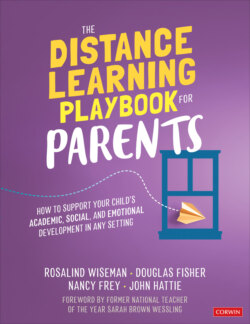Читать книгу The Distance Learning Playbook for Parents - Rosalind Wiseman - Страница 14
На сайте Литреса книга снята с продажи.
Create a Learning Environment
ОглавлениеWe all need a place to work and learn. For most school-age children, that has been in the school building and perhaps a kitchen table or small desk in their room. Learning at home heightens the need for a consistent and convenient place for children to engage in schooling. We’ll start with the ideal and then consider some options.
Ideally, each child will have a location that is “theirs” to work. Ideally, this will not be in their bedroom (and really not on their bed) as their peers, teachers, and adults in the homes of other students do not need to be inside your child’s room. We recognize that the ideal is not always possible. But, ideally, there is a location in which each child has a dedicated space. They do not need to be alone in that space. In fact, it may be better socially for them to spend time together during the day while learning. But they do need a place to keep their things. For example, you might provide your child a bin to hold books, workbooks, notebooks, journals, and other school supplies (crayons, pencils, scissors, etc.).
For example, there are four people in the Green’s home. They decided to convert their dining room, which they rarely used, into a shared workspace. Two adults and two children each have desks in there, and they use headphones while on video calls, much like is done in a call center. As Jeremy, their fourth grader, said, “When Dad is on his calls, we try to be quiet and do our work. And he tries to be quiet when I am in class with Ms. Montez. We all have work to do.” His second-grade sister Sarah said, “We all go to work together after breakfast but sometimes I go outside for class.” In the Green’s home, there is a small fenced yard with a picnic table that has a sun umbrella, and Sarah likes to work there.
Jessica is a single parent of two teenagers. They decided to convert their garage into an office space. As Jessica said, “It turns out that they really liked the project of transforming the garage. They took pictures and documented the whole thing. They created a really cool space for their studies. I have to work outside the home, and I like to check in on them while they’re in their new offices.”
Of course, space is a premium and not all families have garages or dining rooms. We’ll take what we can get. These are the key messages:
➔ Identify a dedicated workspace for each child, ideally outside of their bedroom.
➔ Try to keep the space consistent so that habits form relative to that space.
➔ Keep the supplies needed for learning in that space.
➔ Develop plans for taking breaks, movement, and getting water or food.
➔ Establish ground rules for using the space, including how others in the home should act in that space.
➔ Ask them to leave that space to do other things, such as exercise, eat, and socialize.
